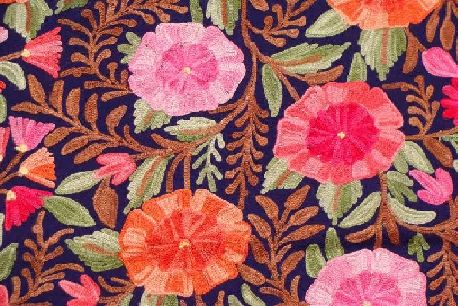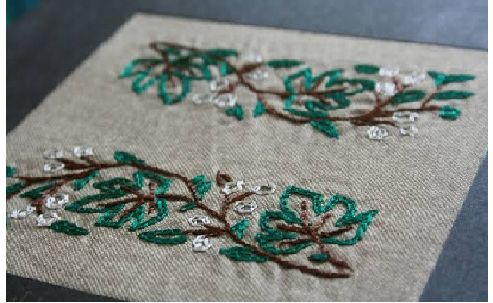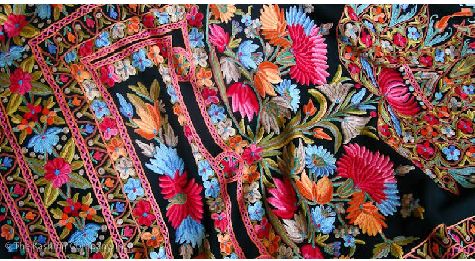Kashida Embroidery
Sep 14, 2019 • 2154 views
History of the Embroidery
The beauty trapped inside the heaven of India - Jammu and Kashmir, is not just limited to picturesque landscapes and hills, for it is a place which has given birth to different art forms as well. One such famous art form is the Kashida or Kasida embroidery. It is one of the ancient traditional form of intrinsic art in India. Originally started in the city of Srinagar, the history of this beautiful embroidery takes us back to the Mughal period. Despite the lack of concrete evidence, it is believed that this embroidery was introduced by Persian Sufi saints. The Mughal era was filled with emperors and royals who appreciated and acted as patrons for different art forms. Sultan Zain-Ul-Abidin is one of the many names in the list of patrons who revolutionised Kashida embroidery. The embroidery, underwent quite some changes over the centuries which resulted due to the social and political scenarios. Kashmir saw a number of rulers such as the Mughals, Afghans, Sikhs and Dogras, and with the changing political powers, Kashida embroidery too saw some alterations.
Design and Style
The spirit of Kashida embroidery lies in its intricate bead and threadwork. The most important feature of this embroidery is that it is done using a single thread. Its formalized appearance is what gives it a distinctive element. This embroidery is usually done on fabrics like silk, wool and cotton using thick and colorful threads. Some of the commonly used colours include white(safed), green(zingari), purple(uda), blue(firozi) and crimson(gulnar). One of the most fascinating features of kashida embroidery is that, often it is done in such a way that the design when finished looks the same on both sides, making it wearable on either of them.

Floral Patterned Kashida Embroidery - Source: WordPress
Kashida embroidery is a very detailed work constituting of a number of stitches and embroidery techniques. The satin stitch, stem stitch, chain stitch, herringbone stitch, darning stitch are some of the frequently used stitches in this embroidery. At one place where satin stitch is used in high quality designs to cover up most of the cloth, chain stitch and stem stitch though being commonly used are more of the supporting kind for they are used in making borders for motifs and in other less focussed places. Some of the main embroidery styles that fall under the category of kashida are - Aari work or hook embroidery, Peppier mache embroidery and Sozni work.

Aari Work in Kashida Embroidery - Source: Utsavpedia
Aari work is defined by its fine and delicate thread work. It makes use of chain stitch. This embroidery incorporates the use of embellishments such as beads and stones which results in a sparkling effect. Aari work is time consuming due to its intricate patterns.
Peppier mache is the kind of style which uses bright colours for the patterns and a black thread for outlining. The motifs and designs embroidered in this style are done using satin stitch.
Sozni embroidery is known for its sophisticated needle work. Satin stitch is the dominating stitch in this style of Kashida embroidery. In this, floral patterns and paisleys are the central elements. Sozni embroidery shows needle work at its finest.
The designs of Kashida embroidery are inspired from nature. The most commonly used motifs in this embroidery include plants, birds like parrots and peacocks, flowers such as lotus and iris, and fruits.
Evolution, Products and Innovation
Kashida embroidery can be considered as a skill that passes on from one generation to another. A legacy that the children carry forward by working as artisans and promoting the art. With the changing times, this embroidery too has seen its own set of changes whether it is the influence of certain socio-political events or the changing marketplace and industry. The style, the designs, motifs and colour combinations all saw certain alterations with the passing years. Without constant advancement of the society, the choices of the people changed and Kashida embroidery adapted itself to this change. Broadening its application, Kashida embroidery slowly started moving on from a designing technique used in shawls and kurtas to being used in different apparels as well as accessories. Currently, a number of products have come in the market which bear the designs of Kashida embroidery. These products include bags, purses, cushion and bed covers, carpets, curtains and many more.

Kashida Embroidery on Cushion Cover - Source: Dolls of India
Kashida and Fashion Industry
Kashida embroidery right from the time of its origin has been a part of the clothing industry. Its beauty and intricacy have always appealed to the men and women in the fashion industry. Whether it is being used by high class fashion designers or by the common people, this embroidery fits and complements anybody and everybody. Bollywood, whose actors and actresses are often seen as fashion icons, too has worked in popularizing this embroidery through outfits worn in different movies as well as in daily life. From Rohit Bal's Gulbagh collection to Manish Malhotra's collection Inaya, all have made extensive use of Kashida embroidery.

Kashida Embroidery on Shawl - Source: Swadesi
Global Influence and Future of the Embroidery
Kashida embroidery has the same impact in the international market as in the national ones. Its beauty and finesse has been recognized by people from all over the world. The fact that this embroidery has an evergreen element to it and can be done on different kinds of cloth such that it can be worn during any season, has added onto its popularity. This embroidery represents the traditional designs and works of Kashmir. Due to its growing popularity, Kashida embroidery is here to stay for a long time, representing the culture of India and making its way to the wardrobes of people from all over the world.
